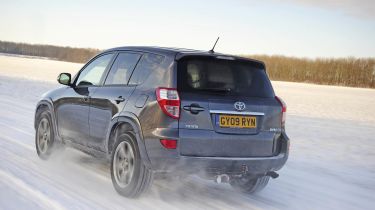Toyota RAV4
New diesel makes compact SUV pioneer an even stronger choice.
It's now 15 years since the RAV4 started the craze for compact, fun-to-drive off-roaders. Skip forward to 2010, and it has a barrage of tough new rivals.
The Toyota fights on a number of fronts. On the one hand, it has to face up to the likes of the compact VW Tiguan and Ford Kuga. On the other, a price of £26,549 puts it squarely within sight of the cars in this test – as does the fact its wheelbase is virtually identical to the CR-V’s.
Over the years, Toyota has followed an evolutionary approach with the RAV4’s styling – and it looks a little old-fashioned as a result. Inside, the dash has a sweeping twin-level design that places the audio controls high up and within easy reach.
The chunky climate control buttons and sporty three-spoke steering wheel are neat details, although comfort is compromised by the fact the driver’s seat doesn’t adjust low enough – tall owners will find leg space cramped.
In the back, the sliding seat is split 60/40 and folds flat, but to ensure decent legroom, passengers will need to keep it in the rearmost position – and even then, there’s less space than in the Hyundai. There’s no seven-seat option, although Toyota’s Easy Flat mechanism is very clever.
It sees the bench plunge into the footwell with the tug of a single lever, leaving a completely unobstructed load area.
With the rear chairs in place, the boot isn’t a particularly practical shape, thanks to the steep sides and short load length. The high-mounted parcel shelf doesn’t help matters, either, while the old-fashioned side-hinged rear door is another irritation – especially if you’re parked in a tight spot.
The RAV4 has always traded on dynamic prowess rather than practicality, and the latest model is no exception. Turn into a corner and the positive steering and taut suspension ensure it responds keenly. Tight body control and decent grip add to the reassuring feel on the road.
Don’t let these talents fool you into thinking the RAV4 isn’t capable off tarmac, though. In the snowy conditions of our test it excelled, thanks to a standard differential lock and a hill descent system, as well as an impressive 4x4 set-up. The extra degree of control provided by the transmission’s sequential manual mode was also useful on the ice-covered roads.
Under the bonnet, our top-of-the-range SR is offered only with Toyota’s new 2.2-litre D-CAT diesel engine. This emits less CO2 than before, at 189g/km, while outputs of 148bhp and 340Nm of torque combine with the low kerbweight
to give brisk pace to match the car’s agility.
Unfortunately, a lack of refinement lets the unit down, while the fidgety ride and excessive road noise at speed also take the edge off the Toyota’s all-round appeal.
Details
WHY: It’s the smallest car here, but the Toyota is the original compact SUV. Can latest updates keep it in the game?







